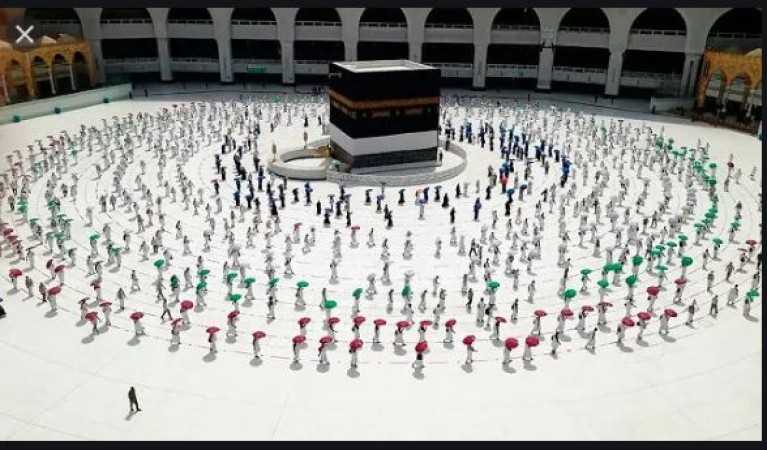
‘Hundreds of thousands offer prayers in desert valley’
The Hajj pilgrimage entered its most testing period for the pilgrims on Friday as hundreds of thousands of Muslims from around the world offering prayers at Mount Arafat in Saudi Arabia.
Emotions ran high as the faithful stood to supplicate in the desert valley where Muslims believe that they will be gathered on the day of judgement. It is also the place when Islam’s founder, Prophet Muhammad (PBUH) delivered his final sermon.
The experience of reaching one of Islam’s holiest sites brought tears among the multitudes of pilgrims at Mount Arafat who sought at salvation and redemption, chanting “Lalbaik Allahhuma labaik, labbaik la sharika laka labbaik, Innal-hamda, wa-nimata laka wal-mulk, la sharika laka (I respond to Your call O Allah (SWT)! I respond to Your call. You have no partner. I respond to Your call. All praise, thanks and blessings are for You. All sovereignty is for You. And You have no partners with You).”
“To stand in Arafat was my last wish before death. And Allah (SWT) has granted me the wish. All praise to Him. Now I can die in peace,” Nazir Ahmad, a resident of Anantnag, told Brighter Kashmir over phone.
Nazir is among nearly 10000 Muslims from J&K who are performing this year’s pilgrimage, the first after the outbreak of Covid-19 pandemic. The pilgrimage was partially resumed this year. Although the Saudi government has ended Covid-19 restrictions for the fully-vaccinated Muslims performing this year’s Hajj, the pilgrims were advised to wear masks after they left for Mount Arafat on Thursday.
“I could feel the presence of Allah (swt). I have never felt so peaceful in my life as I did while offering prayers at Arafat. I can’t describe my feelings in words. It was a spiritual experience which cleansed me from inside,” said Gulshan Ara, another Kashmiri pilgrim.
The last five days of the pilgrimage are the most testing for pilgrims who have to perform a set of rituals associated with the Prophet Muhammad (PBUH) and Islam’s other two prophets - Prophet Ibrahim and his son Prophet Ismail.
The rituals started on Thursday when the pilgrims performed the circumambulation of the Holy Kaaba in Mecca. At sunset on Friday, the pilgrims were bussed or walked all the way to Muzdalifa where they collect the pebbles for symbolic stoning of the devil on Saturday in the village of Mina. Finally, before leaving Mecca, the pilgrims perform another circumambulation of the Holy Kaaba called Tawaf al-Wadaa during which they attempt to kiss or touch the Kaaba’s surface.
Male pilgrims will then shave their heads while women pilgrims will cut off a hair lock in a sign of starting a new, religious life. The end of Hajj is marked by Eid-ul-Azha when Muslims are called upon to offer sacrifice of animals.
‘Hundreds of thousands offer prayers in desert valley’
The Hajj pilgrimage entered its most testing period for the pilgrims on Friday as hundreds of thousands of Muslims from around the world offering prayers at Mount Arafat in Saudi Arabia.
Emotions ran high as the faithful stood to supplicate in the desert valley where Muslims believe that they will be gathered on the day of judgement. It is also the place when Islam’s founder, Prophet Muhammad (PBUH) delivered his final sermon.
The experience of reaching one of Islam’s holiest sites brought tears among the multitudes of pilgrims at Mount Arafat who sought at salvation and redemption, chanting “Lalbaik Allahhuma labaik, labbaik la sharika laka labbaik, Innal-hamda, wa-nimata laka wal-mulk, la sharika laka (I respond to Your call O Allah (SWT)! I respond to Your call. You have no partner. I respond to Your call. All praise, thanks and blessings are for You. All sovereignty is for You. And You have no partners with You).”
“To stand in Arafat was my last wish before death. And Allah (SWT) has granted me the wish. All praise to Him. Now I can die in peace,” Nazir Ahmad, a resident of Anantnag, told Brighter Kashmir over phone.
Nazir is among nearly 10000 Muslims from J&K who are performing this year’s pilgrimage, the first after the outbreak of Covid-19 pandemic. The pilgrimage was partially resumed this year. Although the Saudi government has ended Covid-19 restrictions for the fully-vaccinated Muslims performing this year’s Hajj, the pilgrims were advised to wear masks after they left for Mount Arafat on Thursday.
“I could feel the presence of Allah (swt). I have never felt so peaceful in my life as I did while offering prayers at Arafat. I can’t describe my feelings in words. It was a spiritual experience which cleansed me from inside,” said Gulshan Ara, another Kashmiri pilgrim.
The last five days of the pilgrimage are the most testing for pilgrims who have to perform a set of rituals associated with the Prophet Muhammad (PBUH) and Islam’s other two prophets - Prophet Ibrahim and his son Prophet Ismail.
The rituals started on Thursday when the pilgrims performed the circumambulation of the Holy Kaaba in Mecca. At sunset on Friday, the pilgrims were bussed or walked all the way to Muzdalifa where they collect the pebbles for symbolic stoning of the devil on Saturday in the village of Mina. Finally, before leaving Mecca, the pilgrims perform another circumambulation of the Holy Kaaba called Tawaf al-Wadaa during which they attempt to kiss or touch the Kaaba’s surface.
Male pilgrims will then shave their heads while women pilgrims will cut off a hair lock in a sign of starting a new, religious life. The end of Hajj is marked by Eid-ul-Azha when Muslims are called upon to offer sacrifice of animals.
© Copyright 2023 brighterkashmir.com All Rights Reserved. Quantum Technologies